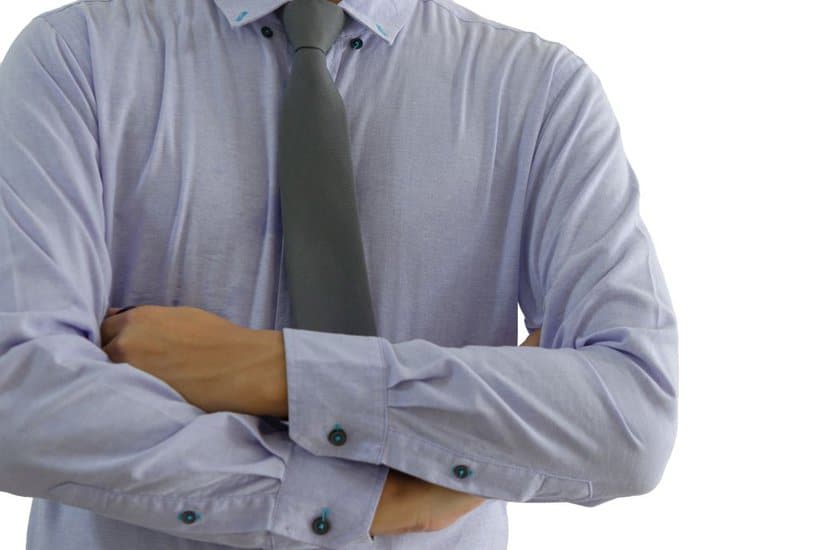Dress shirts can indeed have patterns, and this is a well-established fact that broadens the horizon of men’s fashion. Typically, when one thinks of a dress shirt, the image that often comes to mind is a classic white or light blue solid color.
However, patterns in dress shirts are not only acceptable but also quite popular, adding variety and personal style to traditional professional attire. From subtle to bold, patterns can range widely, including stripes, checks, houndstooth, and even more playful designs.
When incorporating patterns into a dress shirt, the key is to maintain a balance between professionalism and personal expression. The pattern’s scale and color scheme play critical roles in this. Small to medium-sized patterns tend to be more versatile and workplace-appropriate.
On the other hand, large and loud patterns might be more suited for social events or creative environments. In the realm of menswear, variations like plaid, checkered, and striped patterns are staples that offer a harmonious blend of tradition and modernity.
My experience has shown that patterned dress shirts can serve as a focal point in an ensemble or act as a complement to a suit or tie. Coordinating patterns requires attention to detail – ensuring that they do not clash with other elements of an outfit, lest the aesthetic become overwhelming.
Solid suits and ties can balance out a bold shirt pattern, while a subtly patterned shirt can elegantly support a more vibrant tie. The key takeaway is that patterns have a place in dress shirts, and done correctly, they can elegantly enhance a man’s wardrobe.
Can Dress Shirts Have Patterns? The Essentials
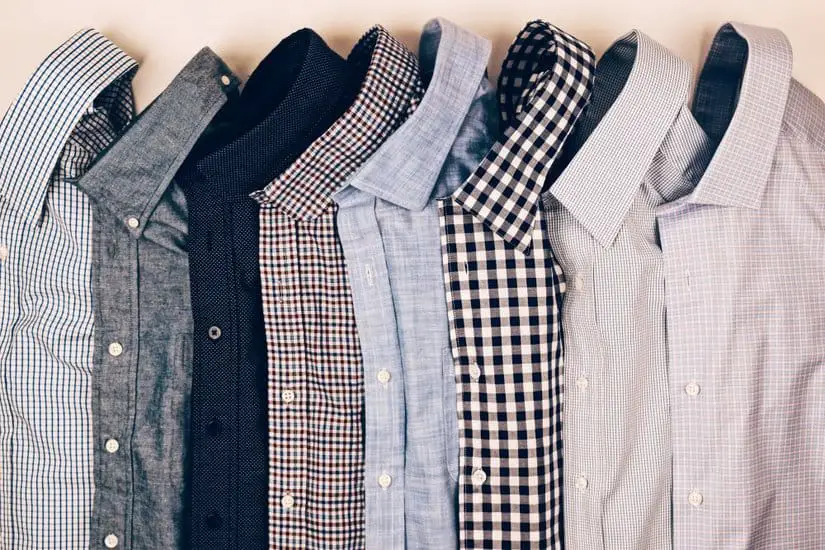
When considering the purchase of a dress shirt, two critical aspects demand my attention: the type of fabric used and the shirt’s construction quality. These elements significantly impact the look, feel, and durability of the shirt.
Check out these other top picks:
- How Do You Button a Dress Shirt?
- Are My Dress Shirt Sleeves Too Long?
- Which Shirts Should Be Tucked In?
Understanding Dress Shirt Fabrics
My immediate scrutiny falls on the material. Dress shirt fabrics can vary significantly, but quality shirts tend to favor natural fibers such as cotton due to their breathability and longevity. The three most common weaves in dress shirt fabrics are:
- Twill: Recognizable by its diagonal rib pattern, twill is soft and drapes well.
- Poplin: Also known as broadcloth, poplin is smooth and has a crisp feel.
- Broadcloth: Similar to poplin but finer, this weave offers a smooth texture that’s suitable for more formal occasions.
Each weave has its own set of characteristics. Twill is durable and resists wrinkles well, while poplin and broadcloth provide a cleaner, sharper look suitable for business or formal wear. The choice of weave impacts the dress shirt fabric’s appearance, influencing both the pattern and colors. I often opt for a fabric based on the context in which I plan to wear the shirt. For instance, a patterned twill might be my go-to for a business-casual setting, while a solid-color broadcloth would be appropriate for a more formal business environment.
Dress Shirt Construction Quality
Moving on to construction quality, I examine how the shirt is made. High-quality dress shirts exhibit several features:
- Stitch density: More stitches per inch equate to better durability and a neater appearance.
- Matching patterns: On a quality shirt, stripes or checks align at the seams.
- Collar and cuffs: These should be free from puckering, with the collar having removable stays for sharpness.
I closely inspect the seams: are they even and without loose threads? The fit is paramount, as the best shirt fabrics can be ill-served by a poor fit. A meticulous construction ensures not only a better fit but also enhances the quality of the shirt, ensuring it looks good and withstands regular wear and ironing.
Types of Dress Shirt Patterns

Dress shirt patterns can either elevate formal attire or inject personality into everyday wear. I’ll explore the essential patterns suitable for both formal environments and casual settings.
Classic Patterns for Formal Settings
Striped Shirts: When it comes to formal wear, stripes are a staple. Vertical stripes are particularly sought-after as they create a slimming effect and convey a sense of professionalism. Typically, thinner stripes suggest a more subdued, formal look, whereas wider stripes can be slightly more casual.
- Houndstooth: This intricate pattern is characterized by small, broken checks resembling a hound’s tooth. It’s often found in subtle colors and is a traditional choice for business settings.
- Pinstripes: Very thin stripes running vertically offer a classic aesthetic that’s closely associated with professional business attire.
Casual Patterns for Everyday Wear
Plaid: For a more relaxed appearance, plaid is my go-to pattern due to its versatility and timeless design. It’s a pattern that can range from simple and subtle designs to bold, colorful variations making it suitable for a range of casual occasions.
- Checkered: Squares of color, known as checks, create a playful yet structured pattern, which can vary in size from micro-checks to large windowpane designs.
- Polka Dot: These evenly spaced dots bring a fun and energetic feel to a dress shirt, perfect for informal gatherings or as a statement piece under a neutral blazer.
- Horizontal Stripes: Less common than vertical stripes, horizontal stripes offer a bolder and more relaxed feel, great for casual outings or weekend wear.
Each of these patterns can serve to express personal style while still maintaining the balance between smart and informal.
Color and Pattern Coordination
When considering the complex interplay of colors and patterns in a dress shirt, I focus on harmony between my suit, tie, and shirt. Achieving a polished look is all about balance.
Pairing Patterns with Suits and Ties
For a classic and fail-safe approach, I suggest pairing a patterned dress shirt with a solid tie. This allows me to introduce visual interest without overwhelming the eye. Here’s a practical example:
- Blue Shirt: A safe bet to combine with a wide range of suits and ties. If I choose a blue shirt with a subtle pattern, I might select a solid navy tie which resonates with professional and formal settings.
On the opposite spectrum, if I wear a solid dress shirt, like a crisp white, it gives me the leeway to opt for a tie with more elaborate patterns. I find that a white shirt serves as a silent canvas, allowing a tie with stripes or paisley designs to stand out — tastefully.
When combining patterns, I adhere to a simple rule: different sizes. A finely striped shirt can be elegantly complemented by a tie with broader stripes. This contrast in pattern scales ensures that no single element fights for attention.
As for colors, I recommend working with complementary shades. A lavender shirt pairs well with a tie that features hints of purple or gold, especially if I’m aiming to add a pop of color to a neutral suit. However, I avoid colors that clash, which can disrupt the visual flow of my attire.
Much like an artist blends colors on a palette, I consider the impact of different hues and tones. A blue shirt can be enhanced with a tie in a shade of blue that is either distinctly lighter or darker, maintaining cohesion without being too “matchy.”
I apply similar principles when integrating colored suits into my ensemble. For instance, a space blue suit can be complemented with a lighter blue shirt, and I’d complete the look with a tie that might incorporate subtle accents of blue to tie everything together, possibly with hints of complementary colors like gold for a touch of sophistication.
Design Elements of Dress Shirts

In terms of design, dress shirts can exhibit a diverse range of styles through the specifics of their collars, cuffs, buttons, and buttonholes. These elements not only define the functionality and formal nature of a dress shirt but also contribute to its aesthetic appeal and distinctiveness.
Collars and Cuffs
Collars are a focal point of dress shirts and come in various shapes. The spread collar is versatile and accommodates a wide range of tie knots, while the button-down collar provides a neat, anchored appearance without a tie. For formal occasions, French cuffs—fabric that’s folded back and fastened with cufflinks—offer an elegant statement, whereas barrel cuffs with single or double buttons are a classic choice for daily wear.
- Fabric selection, such as mother of pearl for buttons, is considered a mark of quality and gives shirts a subtle luster and sophistication.
- Monograms are often added to cuffs or pockets, serving as a personalized touch.
Buttons and Buttonholes
- Buttons play a functional role and are an opportunity for detail; they can be simple or intricate, with high-end shirts often featuring mother of pearl buttons.
- Buttonholes are crafted with precision to ensure durability and ease of fastening. Their placement and spacing can affect the shirt’s fit and look.
The detail in the stitching of buttonholes speaks to the overall quality of the shirt, with tightly woven fabrics usually bearing closely spaced stitches. My attention to these elements ensures that the dress shirts not only are crafted for longevity but also hold a polished appearance.
Fit and Comfort
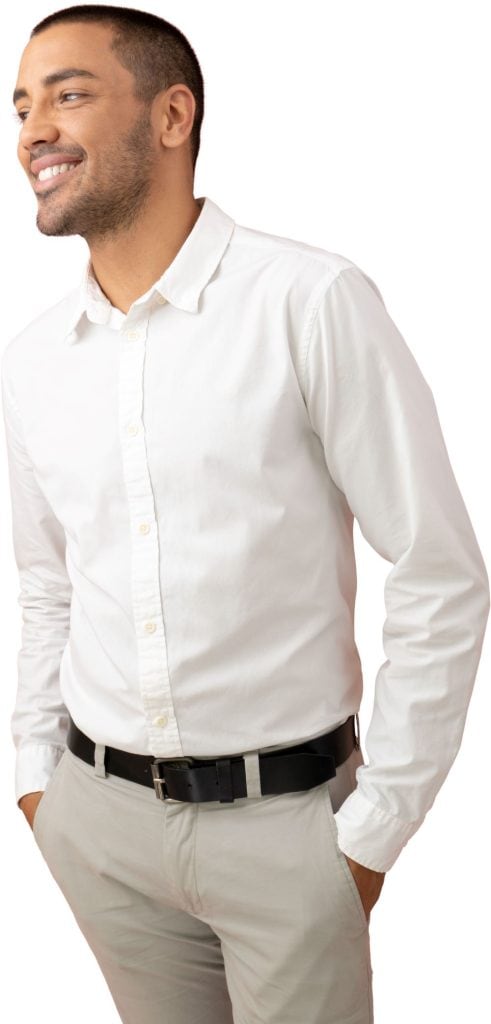
When choosing a dress shirt, the weave of the fabric is a crucial aspect that influences both fit and comfort. I’ll explore how the weave can affect the feel of a shirt on your skin, and its overall fit on your body.
The Impact of Weave on Fit
Different weaves offer varying qualities that can influence the comfort level of dress shirts. Twill weaves, for example, are easily identifiable by their diagonal rib pattern. This weave creates a texture that can be both visually appealing and conducive to a comfortable fit, as the fabric typically drapes well and provides a slight natural stretch.
Poplin, also known as broadcloth, is a smooth and lightweight weave. Shirts made from poplin are often considered to be soft to the touch and highly suitable for those looking for a combination of a sleek appearance with a comfortable fit.
There are also distinctive weaves, such as dobby and Jacquard, where geometric patterns are woven into the fabric itself. These can add an element of texture and depth to a dress shirt without affecting the breathability or comfort. A quality construction using these weaves can result in a shirt that feels light and breathable, while also being moisture-wicking.
It’s essential to consider these weaves when selecting a dress shirt for their potential to offer a soft and comfortable fit, which are qualities that directly contribute to the wearer’s comfort throughout the day.
Dress Shirt Versatility
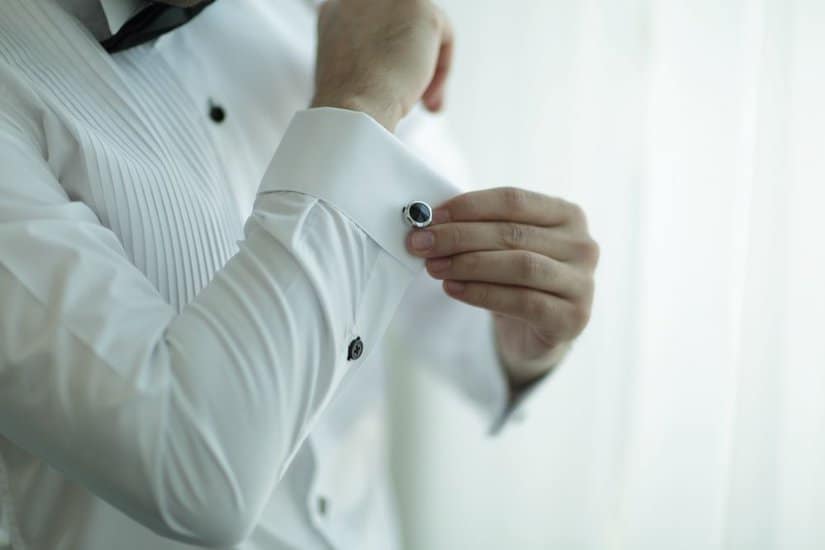
In my experience crafting a versatile wardrobe, men’s dress shirts stand as a wardrobe essential due to their ability to adapt to various settings with ease. Whether opting for a solid color or a casual pattern, the transition from formal to informal occasions can be seamless.
From Office to Casual
A white shirt serves as a quintessential piece in any man’s closet. It’s the ultimate wardrobe essential for both serious and leisurely engagements. With a solid white shirt, I can easily transition from a professional setting where the shirt anchors a suit and tie, to a casual gathering, just by removing the jacket and loosening the top button.
For days when a solid color feels too strict, I incorporate patterned dress shirts to add a hint of personality. The same men’s dress shirt that is fit for the boardroom, with subtle stripes or a discreet check pattern, can quickly adapt to a weekend lunch when paired with jeans or chinos.
A casual pattern on a dress shirt should never be underestimated. It injects an element of ease into my wardrobe that’s pivotal for those days when the setting isn’t quite formal but demands a degree of sophistication.
Sometimes, substituting a tailored jacket with a knit sweater or a polo shirt turns the common office attire into an ensemble perfect for casual Fridays or an impromptu dinner date.
By carefully selecting the dress shirts in my collection, with an eye for versatility, I ensure that solid shirts and those with patterns play a versatile role – working doubly hard to span the spectrum of social and professional engagements.
Dressing for the Occasion
When I approach dressing for a particular event, I focus on the appropriateness of my attire in terms of formality and style. This includes selecting the right dress shirt that not only matches the required dress code but also complements my overall ensemble.
Selecting the Right Dress Shirt for Events
For formal events, my first consideration is choosing a dress shirt with a pattern that is subtle and sophisticated. It’s essential that the shirt maintains a level of formality, especially if it’s to be paired with a suit or jacket. Typically, I opt for patterns like pinstripes or a discreet herringbone that won’t detract from the overall polish of formal attire.
When considering the fit of my dress shirt, I pay close attention to the yoke and shoulder measurements to ensure a tailored silhouette. The sleeves should be long enough to allow a bit of the cuff to peek out from under the jacket, while the collar style should complement the lapels of my jacket or suit and leave enough room for my tie knot.
The selection process also involves deciding between various collar styles. A spread collar provides a modern, versatile look that pairs well with or without a tie, whereas a point collar offers a more traditional appeal, optimal for business or conservative events.
A dress shirt with a proper fit isn’t just about looking good; it’s also about feeling confident. This is why I always make sure my dress shirts are snug, but not tight, across the chest and waist, avoiding any excess fabric that can billow out when tucked in.
Pairing the shirt with the rest of my attire is the final step. For formal occasions, I make sure my tie complements the shirt’s pattern without clashing, and for a seamless look, I ensure my belt and shoes sync up with the overall color scheme.
Through careful selection and attention to detail, a well-chosen dress shirt with the right pattern can elevate my presence at any occasion, reinforcing my confidence and ensuring I’m dressed appropriately for the setting.
Care and Maintenance

When it comes to maintaining my dress shirts, I understand that proper care is crucial to ensure their longevity and keep them looking smooth and sharp. The fabric type and pattern complexity require attention to detail to preserve the shirt’s appearance and quality.
Ensuring Longevity and Appearance
My approach to dress shirt maintenance begins with the fundamental understanding that the material dictates the care process. For instance, high-quality cotton shirts are known for their softness and durability, but they tend to wrinkle more easily than blends.
I tackle this issue by opting for a wrinkle-resistant finish when available, or I prioritize gentle ironing techniques. It’s also imperative for me to use the correct laundering settings — cooler water for darks and warmer for light colors, while always keeping in mind the fabric’s heat tolerance.
To maintain the shirt’s smoothness and details, like collar stays and buttons, I take them out before washing, and I ensure not to overcrowd the washing machine. This prevents unnecessary friction that could damage its appearance. Upon washing, I hang them promptly to maintain their shape and reduce wrinkles, confirming the shirt’s thickness and weight are supported.
I always read the care label, especially when dealing with blends, as the mix of fabrics might necessitate a different approach. Lightweight and thin materials, for example, often require a gentle cycle to prevent wear. As I fold or hang my dress shirts, I take care to smooth out any remaining wrinkles to maintain a polished look, a step that’s especially crucial for ensuring my dress shirts are ready-to-wear for any occasion.
The Evolution of Men’s Dress Shirts
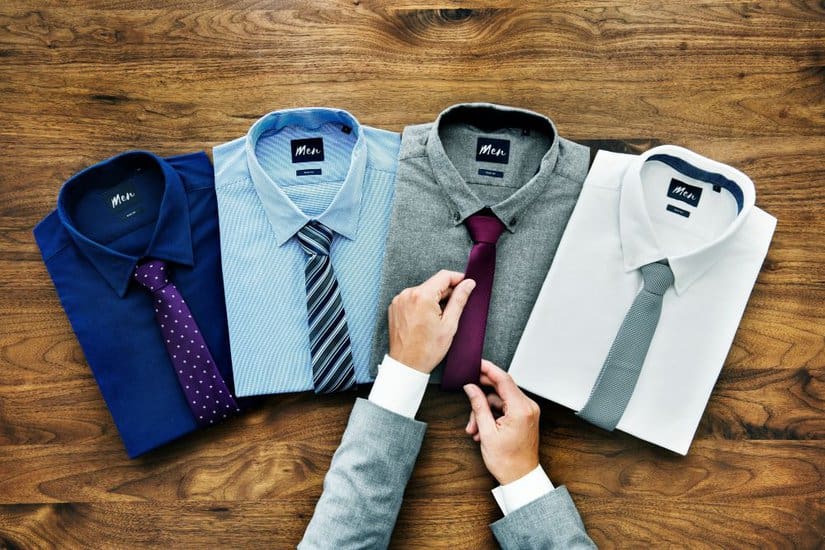
Men’s dress shirts have undergone significant changes in fabric and design, paralleling shifts in demand and menswear trends. Let’s explore the innovations that have led to today’s sophisticated range of shirt fabrics.
Innovations and Trends in Shirt Fabrics
The journey of men’s dress shirts begins with a need for functionality mixed with a touch of class. I’ve observed that early shirts, serving as undergarments, were made from linen or wool, providing a loose fit for comfort and practicality. But as I explore the history of dress shirts for men, it becomes clear that the dress shirt was destined for more than a mere base layer.
As men’s fashion evolved, so did the materials used for dress shirts. Cotton emerged as a prime choice for its breathability and ease of care, leading to the development of fabrics like broadcloth, which gave the shirts a smooth, elegant finish. Broadcloth in particular became a cornerstone in a man’s wardrobe, especially in professional settings.
Another turning point I notice is the introduction of the end-on-end broadcloth, where threads of alternating colors create a subtle texture that’s visually dynamic yet appears solid from a distance. This textile ingenuity highlights the evolution from simple unadorned garments to pieces that subtly express personal style without breaking formal dress codes.
In the realm of textures, the weaves of dress shirts stand out. For instance, the oxford weave is not just durable but its basketweave pattern adds a unique tactile dimension. This has made it a favorite for settings that land between formal and casual, such as pairing with polo shirts for a preppy look.
Moving into more complex territories, patterns like the royal oxford and twill fabric add sophistication to the dress shirt. The royal oxford weave is known for its distinctive shine and texture, whereas the twill fabric is recognized by its diagonal ribbing, offering durability and a slight sheen, perfect for those seeking the perfect dress shirt that pairs well with business and semi-formal attire.
The demand for variety in menswear has also seen a surge in patterned dress shirts. Moving away from solid colors, these patterns range from discrete to bold, catering to personal style and modern fashion demands. Whether it’s the power of the pinstripe or the casual charm of gingham, patterned fabrics have become a mainstay in contemporary menswear, turning the traditional dress shirt into a statement piece of self-expression.
Frequently Asked Questions

As an expert in men’s fashion, I’m here to address common inquiries regarding the place of patterned shirts in a formal wardrobe.
Are patterned shirts considered formal wear?
Yes, patterned shirts can be seen as formal wear. Stripes, for instance, are traditionally formal, with thinner stripes seen as more formal, and similarly, closer-together stripes enhance formality.
What are the rules for wearing a patterned dress shirt with a suit?
When pairing a patterned dress shirt with a suit, it’s key to maintain balance; opt for a subtle pattern if the suit is bold, or a bolder pattern if the suit is plain. Ensure the shirt complements the suit in color and scale of pattern.
How many dress shirts should a man have in his wardrobe?
A man should typically have a minimum of five dress shirts in his wardrobe to allow for rotation, ensuring a selection for various occasions, including both solid and patterned options.
Is it appropriate to wear a tie with a patterned dress shirt?
Absolutely. Wearing a tie with a patterned dress shirt is appropriate. The tie should have a contrasting pattern or be a solid color to avoid clashing.
What are the differences between dress shirts and casual button-down shirts?
Dress shirts are typically tailored for a more formal look and made from finer fabrics, while casual button-down shirts may have a looser fit and are often crafted from more durable, daily-wear fabric.
How can one style a patterned shirt for a professional setting?
For a professional look, style a patterned shirt with a tailored suit or a smart blazer. Ensure the pattern is subtle and colors are conservative to maintain professionalism.

Samoel Ovanessian is the founder and creator of StylishAlpha.com – a website dedicated to men’s fashion. As a proud owner of more than 200 ties, he loves digging through new clothing combinations for everyday use, formal events and even just for fun. You can read more about Samoel here.

